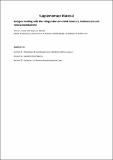Files in this item
Halogen bonding with the halogenabenzene bird structure, halobenzene and halocyclopentadiene
Item metadata
| dc.contributor.author | Cates, Emma L. | |
| dc.contributor.author | van Mourik, Tanja | |
| dc.date.accessioned | 2020-05-28T23:37:43Z | |
| dc.date.available | 2020-05-28T23:37:43Z | |
| dc.date.issued | 2019-09-15 | |
| dc.identifier | 258950126 | |
| dc.identifier | f47f17df-bfe4-4492-9137-eaf794060c94 | |
| dc.identifier | 85066459287 | |
| dc.identifier | 000478587800005 | |
| dc.identifier.citation | Cates , E L & van Mourik , T 2019 , ' Halogen bonding with the halogenabenzene bird structure, halobenzene and halocyclopentadiene ' , Journal of Computational Chemistry , vol. 40 , no. 24 , pp. 2111-2118 . https://doi.org/10.1002/jcc.25863 | en |
| dc.identifier.issn | 0192-8651 | |
| dc.identifier.other | ORCID: /0000-0001-7683-3293/work/58055468 | |
| dc.identifier.uri | https://hdl.handle.net/10023/20007 | |
| dc.description | We thank EastCHEM for support via the EaStCHEM Research Computing Facility. The research data supporting this publication cab be accessed at https://doi.org/10.17630/a3b1f172-dd54-4df1-a498-9951cfce9cee. | en |
| dc.description.abstract | The ability of the “bird-like” halogenabenzene molecule, referred to as X-bird (X= Cl to At), to form halogen-bonded complexes with the nucleophiles H2O and NH3 was investigated using double-hybrid density functional theory and the aug-cc-pVTZ/aug-cc-pVTZ-PP basis set. The structures and interaction energies were compared with 5-halocyclopenta-1,3-diene (halocyclopentadiene; an isomer of halogenabenzene) and halobenzene, also complexed with H2O and NH3. The unusual structure of the X-bird, with the halogen bonded to two carbon atoms, results in two distinct σ-holes, roughly at the extension of the C-X bonds. Based on the behaviour of the interaction energy (which increases for heavier halogens) and van der Waals (vdW) ratio (which decreases for heavier halogens), it is concluded that the X-bird forms proper halogen bonds with H2O and NH3. The interaction energies are larger than those of the halogen-bonded complexes involving halobenzene and halocyclopentadiene, presumably due to the presence of a secondary interaction. | |
| dc.format.extent | 1201559 | |
| dc.format.extent | 750951 | |
| dc.language.iso | eng | |
| dc.relation.ispartof | Journal of Computational Chemistry | en |
| dc.subject | Halogen bond | en |
| dc.subject | Halogenabenzene | en |
| dc.subject | Halobenzene | en |
| dc.subject | Halocyclopentadiene | en |
| dc.subject | Double hybrid density functional theory | en |
| dc.subject | QD Chemistry | en |
| dc.subject | DAS | en |
| dc.subject.lcc | QD | en |
| dc.title | Halogen bonding with the halogenabenzene bird structure, halobenzene and halocyclopentadiene | en |
| dc.type | Journal article | en |
| dc.contributor.institution | University of St Andrews. Centre for Research into Equality, Diversity & Inclusion | en |
| dc.contributor.institution | University of St Andrews. EaSTCHEM | en |
| dc.contributor.institution | University of St Andrews. School of Chemistry | en |
| dc.identifier.doi | 10.1002/jcc.25863 | |
| dc.description.status | Peer reviewed | en |
| dc.date.embargoedUntil | 2020-05-29 |
This item appears in the following Collection(s)
Items in the St Andrews Research Repository are protected by copyright, with all rights reserved, unless otherwise indicated.


